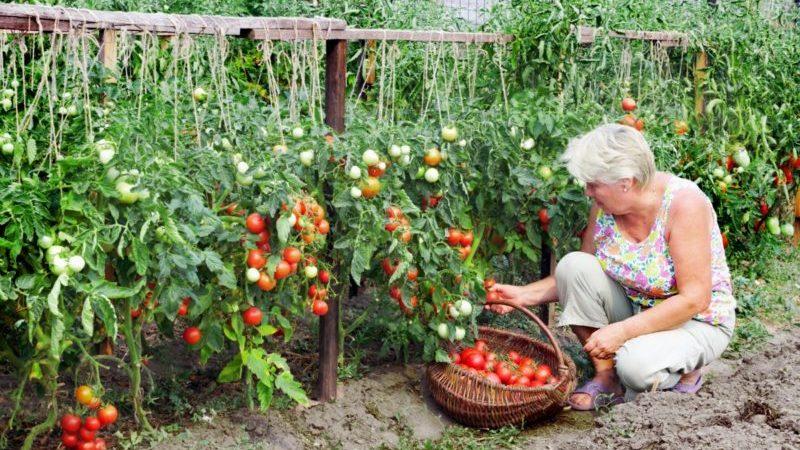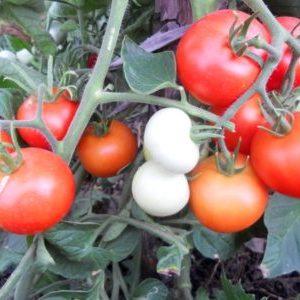A favorite of domestic summer residents, the most unpretentious in care and at the same time high-yielding tomato “Apple Tree of Russia”
They say that a lazy summer resident is a bad summer resident. However, there are varieties of tomatoes that can be grown even by beginners in gardening and people who have very little time to care for their plants. One of these varieties is the Yablonka Rossii tomato.
People call it “tomato for the lazy.” It's all about the unpretentiousness of such tomatoes.
Characteristics and description of the variety
The early tomato variety Yablonka Rossii is successfully grown both in greenhouses and in open ground. The fruits ripen 90-120 days after the first shoots appear.
Fruit ripening is very smooth. The Russian climate is excellent for rich fruiting of the variety. Plants are resistant to major tomato diseases and the vagaries of nature.
Distinctive features
Yablonka tomatoes of Russia are medium-sized. Bushes grown in open beds reach a height of 1.3 m. Greenhouse tomatoes of this variety grow a little higher (up to 1.7 m). The leaf color is green, the size is medium. Intermediate simple inflorescences are formed. The first inflorescence appears above the 7-9 leaves.
Reference. The main difference between this tomato and other varieties is in the shape of the leaves. Outwardly, they look like apple leaves, which explains the name of the variety. The similarity is especially noticeable on young plants. The older the plant, the more its leaves look like potato leaves.
Standard apple bushes. They do not have to be pinched and tied up.The plant forms many ovaries and bears fruit well.
Fruit characteristics and yield
Ripe tomatoes have a bright red color with a glossy sheen. They are strong and resistant to cracking.
The tomatoes are round in shape. Each fruit weighs on average 80 g. The maximum weight is 100 g. From 5 to 9 ovaries are formed on one hand. With proper care, up to 100 fruits can be harvested from one bush. In weight terms, this is 10 kg per bush.
The tomatoes are smooth with a thin, dense crust. The fruits have no more than 5 seed chambers, but one tomato produces a lot of seeds. Two fruits are enough to provide yourself with seeds for the next year.
The fruits are highly juicy. The taste is sweet with sourness.
How to grow seedlings
Yablonka Russia tomatoes are grown in seedlings. Seedlings are sown in early March. For this, seeds are prepared. Then they are placed in containers with soil, wait for shoots to emerge and care for the sprouts until planting the plants in a greenhouse or open ground.
Preparing seeds, containers and soil
Before sowing, the seeds are prepared by treating them in a manganese solution, which promotes disinfection. It is recommended to dry the processed seeds.
Sow tomato seedlings Yablonka Rossii either in a common large container, or immediately in separate cups (peat or cardboard cups are suitable). In the latter case, it is easier to transfer the sprouts to a permanent location without injury.
It is recommended to use a self-created mixture as soil for seedlings. It is prepared in advance: mix one part of garden or turf soil, 2 parts of peat, 1 part of humus, 0.5 parts of sand, 10 g of urea, 30 g of superphosphate and 10 g of any potash fertilizer.
Important! To prepare the soil, use peat with low acidity (pH 6.5). If necessary, add sifted wood ash or dolomite flour to the mixture to reduce the acidity.
The prepared mixture requires sifting and disinfection.
To remove weed seeds, fungal spores and pathogenic bacteria from the soil:
- calcination in the oven at 200ºC for 15 minutes;
- heating in a microwave oven at a power of 850 W for 2 minutes;
- watering with boiling water or a strong solution of manganese.
Important! Using garden mixture to prepare the soil, take it from beds where nightshade crops (tomatoes, peppers, eggplants, potatoes) have not previously grown.
Sowing
Before sowing the seeds, the soil is moistened. It is recommended to evenly place the seeds over the surface of the container, and then cover them with a 1 cm layer of soil. Next, re-wetting with a spray bottle is required.
The container with the seeds is covered with cellophane. This will keep it moist.
Growing and care
The seedlings are placed in a warm place with a temperature of 25 to 28 degrees. After the first sprouts appear (after 5-7 days), the film is removed and the containers are placed in a well-lit room.
When growing seedlings in one common container, they are planted in separate cups after 7-12 days, when the first true leaves appear on the sprouts.
Important! When replanting seedlings, you should take each sprout with a lump of earth so as not to damage the root system.
How to grow tomatoes
At the beginning of April, seedlings are hardened off so that they can better take root in open ground and withstand bad weather. Apple trees are planted in open ground after 60 days from germination.
Reference. It is recommended to plant Russian Yablonka tomatoes on land where root crops, pumpkins or legumes previously grew.
Landing
A favorable time for planting seedlings of the variety in question in the ground is the beginning of May. It is important that there are no night frosts at this time. Plants are transplanted into the greenhouse at the end of April.
Algorithm for preparing soil for planting tomatoes:
- digging up the site;
- weed removal;
- creating holes for seedlings measuring 70 by 70 cm;
- adding humus and superphosphate to the holes;
- adding lime (only for acidified soil).
Important! When choosing a place for planting Yablonka Russia tomatoes, take into account sufficient sunlight and protection from draft winds.
The holes prepared for seedlings are watered, lumps with plant roots are placed in them, carefully sprinkled with soil and watered again. The holes for the variety in question are located at a distance of at least 60 cm from each other. For good growth, the Apple tree needs space.
Care
2 weeks after planting the tomatoes, nitrogen fertilizing is applied to the soil under each bush.
Russian Yablonka tomatoes love water, but too much moisture can destroy the plant. Watering the tomatoes recommended as the soil dries out. After each watering, the top layer of soil is loosened.
Reference. Experts recommend using a drip irrigation system for the tomato variety in question. This saves maximum time and effort, and also makes it possible to easily apply liquid fertilizer.
Feeding applied three times during the entire growing season. The plant is watered with a solution of water with ammonium nitrate, superphosphates or potassium chloride.Experienced gardeners use self-prepared infusions of onions, weeds, banana peels, as well as a solution of dry yeast as top dressing.
There is no need to form apple bushes and remove stepsons. During the fruiting period, the bushes are tied to a support. In one night, fruits that ripen together are capable of throwing an untied bush to the ground.

Diseases and pests
According to experts, Yablonka tomatoes are highly resistant to common tomato diseases (fusarium, alternaria, late blight and verticillium). However, some summer residents leave reviews mentioning defeat late blight. If this disease has affected your plants, use special chemical compounds and folk remedies to combat it.
Important! When treating plants against late blight, it is recommended not to use the same product. Getting used to it, the disease will cause more and more damage to the plant. It is optimal to use a special chemical product first, and next time a folk one, and so on.
Insecticides and folk remedies (infusions of wormwood, dandelion, potato tops and tobacco dust) help in pest control.
Pests, capable of attacking the variety in question:
- aphid;
- spider mite;
- thrips;
- Colorado beetle.
The nuances of growing in open ground and in a greenhouse
The Russian apple tree grows well in open ground. However, in regions with harsh climates, the plant will only survive in a heated greenhouse. Greenhouses and greenhouses without heating are also excellent for growing, with the exception of the Far North.
When grown in a greenhouse, seedlings are transplanted by the end of April. For open ground, seeds are sown in early March, transplanted into beds only in May.
Harvesting and application
Depending on the manufacturer of Yablonka Russia tomato seeds, the packaging indicates a different period of fruit ripening - from 90 to 120 days. Gardeners note that the maximum ripening period is 125 days.
Due to their good taste, rich aroma and small size, tomatoes are used both fresh and for canning. They are also processed into juice and paste. The ideal combination of taste with all types of vegetable oils allows them to be used for preparing various dishes.
The resistance to cracking and density of tomatoes contribute to their long-term storage and preservation of their presentation during transportation. It is recommended to store Yablonka Rossii tomatoes in a cool place (refrigerator or basement).
Advantages and disadvantages of the variety
No disadvantages were noticed in the variety in question. There are plenty of positive qualities:
- early ripening;
- disease resistance;
- attractive appearance of the fruit;
- the possibility of growing not only in a greenhouse, but also in open ground;
- unpretentiousness and ease of cultivation;
- high productivity;
- preservation of shape, taste and appearance during transportation;
- pleasant taste.
Farmers' opinions
Novel: “I never tire of repeating that Yablonka is my favorite tomato variety. I've been growing this for four years. There is little time for care, so the plants mostly grow on their own. We have never been sick with anything. The harvest is excellent."
Olesya: “Tomatoes are very tasty. They are unpretentious in care. But last year we were among the first to become infected with late blight. We lost 4 bushes out of 15. The rest were saved. About 5 kg were collected from the bush. This year they planted it again.”
Vitaly: “I plant Apple tomatoes exclusively for pickling.My wife wraps them whole in jars. This is how we provide for ourselves and sell. The harvest is rich. They’re not bad when fresh, but I prefer the Ox’s Heart. We always make fresh salads from it.”
Conclusion
Yablonka tomatoes are a real godsend for modern farmers who want to get a large harvest in a short time without making significant efforts. High yields reward not only meticulous gardeners who value every tomato bush, but also busy owners of large greenhouse farms.